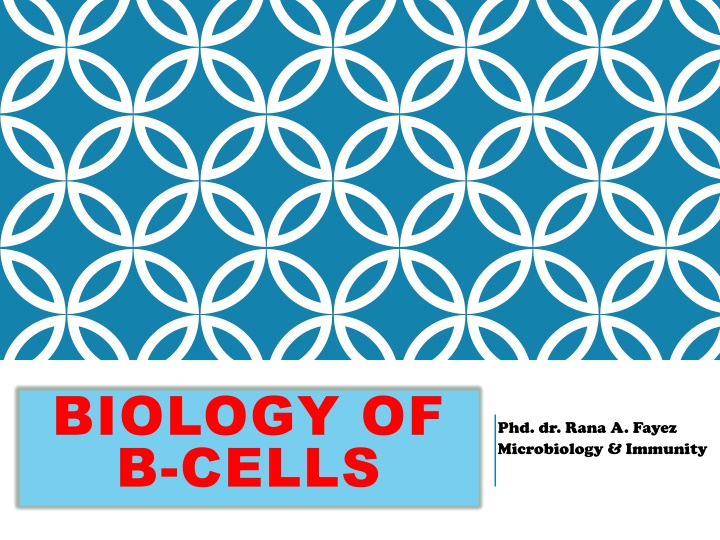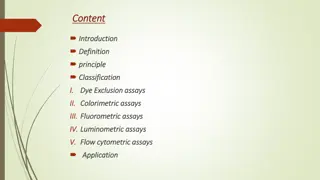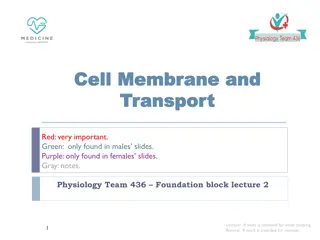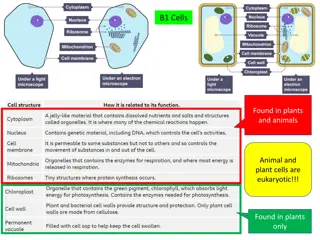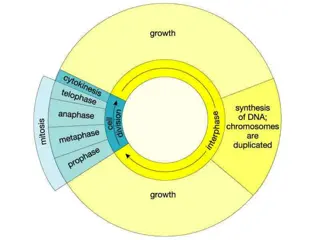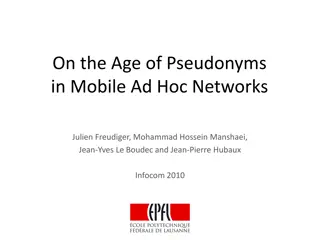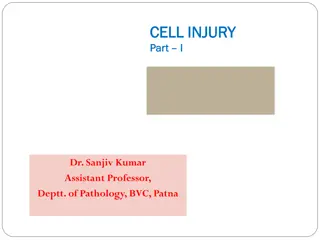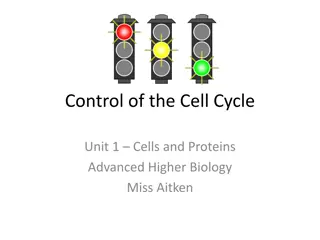Insights into B-Cell Function and Location
B-cells play a crucial role in the adaptive immune system by producing antibodies to combat pathogens. They develop in the bone marrow and are located in key lymphatic organs like the spleen and lymph nodes. The antigen recognition process by B-cells is essential for immune response activation.
Download Presentation

Please find below an Image/Link to download the presentation.
The content on the website is provided AS IS for your information and personal use only. It may not be sold, licensed, or shared on other websites without obtaining consent from the author.If you encounter any issues during the download, it is possible that the publisher has removed the file from their server.
You are allowed to download the files provided on this website for personal or commercial use, subject to the condition that they are used lawfully. All files are the property of their respective owners.
The content on the website is provided AS IS for your information and personal use only. It may not be sold, licensed, or shared on other websites without obtaining consent from the author.
E N D
Presentation Transcript
BIOLOGY OF B-CELLS Phd. dr. Rana A. Fayez Microbiology & Immunity
WHERE ARE B CELLS LOCATED? B cells exist in different places depending on their stage of development. In fetuses, the liver makes B cells. Once you re born, B cells develop in the spongy tissue inside your bone called bone marrow. They start as hematopoietic stem cells and eventually become B cells during a process called hematopoiesis. Once they re fully mature, your B cells travel to important parts of your lymphatic system, including your spleen and lymph nodes.
Function Why are B cells important? B cells are an important part of your adaptive immune system. Your immune system includes your innate immune system and your adaptive immune system. While your innate immune system is your first defense against any threat, your adaptive immune system is specialized to recognize and fight particular types of threats (a particular virus, bacteria, etc.). B cells produce antibodies that destroy antigens or the pathogen associated with a particular antigen.
ANTIGEN RECOGNITION BY B CELLS the BCR BCR (surface membrane immunoglobulin) interacts with a much larger larger area of an intact antigenic epitope antigenic epitope that generally has conformational or planar structure or planar structure. Consequently, the B cell has no requirement for antigen processing and may directly recognize antigen. Although antigen may sometimes be associated with the surface of an APC, the epitopes remain intact and are bound by the BCR without prior processing intact conformational
B-cell antigen recognition may be thymus independent thymus dependent thymus dependent. Thymus independent (T-independent) recognition is a relatively uncommon event and is restricted to antigens composed of polymers of simple repeating structural units. thymus independent or
ACTIVATION OF THE B LYMPHOCYTE 1 The activation of a na ve B cell is not dissimilar to the process of T-cell activation The B cell requires three specific signals in order to become fully activated Signal Signal 1 1 for B-cell activation is the recognition of antigenic epitope epitope by the surface membrane BCR. Signal transduction for the BCR is undertaken by a complex of CD79a and CD79b Signal Signal 2 2 comprises intermolecular interactions intermolecular interactions between surface molecules on that B cell . One such interaction results from the B cell internalizing antigen and presenting peptide fragments associated with MHC class II molecules. Signal Signal 3 3 for B-cell activation takes the form of a co stimulatory cytokine stimulatory cytokine released by the Th cell that binds to a cytokine receptor on the surface of the B cell. A range of cytokines act in this fashion (depending on the nature of the antigen, the subset of Th cell and the type of immune response required) including IL-4, IL-5, IL-13, TGF- and IFN- . recognition of antigenic co- -
1- Immature bone marrow B cells undergo a process similar to the negative selection negative selection of developing intra-thymic T cells. Alternatively, the B cell may undergo further gene rearrangements within the light chain and express a new BCR. If this new receptor is not self-reactive, the cell will be deleted but if not, the cell will be exported for further maturation in the periphery. This process is known as receptor editing receptor editing.
2. B-CELL MATURATION OVERVIEW OF B- CELL DEVELOPMENT . During the antigen- independent maturation phase, immunocompetent B cells expressing membrane IgM and IgD are generated in the bone marrow. Only about 10% of the potential B cells reach maturity and exit the bone marrow. Naive B cells in the periphery die within a few days unless they encounter soluble protein antigen and activated TH cells. Once activated, B cells proliferate within secondary lymphoid organs. Those bearing high-affinity differentiate into plasma cells and memory B cells, which may express different isotypes because of class switching.
A) PROGENITOR B CELLS A) PROGENITOR B CELLS PROLIFERATE IN BONE MARROW PROLIFERATE IN BONE MARROW Bone-marrow stromal cells are required for maturation of progenitor B cells into precursor B cells. stem cell factor (SCF) VCAM-1 :Vascular cell adhesion molecule- Progenitor B cell (pro-B cell) precursor B cells (pre-B cells)
B) IG-GENE REARRANGEMENT PRODUCES IMMATURE B CELLS Sequence of events and characteristics of the stages in B-cell maturation in the bone marrow.
C) THE PRE C) THE PRE B B- -CELL RECEPTOR IS ESSENTIAL FOR RECEPTOR IS ESSENTIAL FOR B B- -CELL DEVELOPMENT CELL DEVELOPMENT CELL immunoglobulin and surrogate light chain at different stages of B-cell differentiation in the bone marrow.
D) SELF D) SELF- -REACTIVE B CELLS REACTIVE B CELLS ARE SELECTED IN BONE ARE SELECTED IN BONE MARROW MARROW Experimental evidence for negative selection (clonal deletion) of self-reactive B cells during maturation in the bone marrow
3 3.B .B- -CELL ACTIVATION AND CELL ACTIVATION AND PROLIFERATION PROLIFERATION After export of B cells from the bone marrow, activation, proliferation, and differentiation occur in the periphery and require antigen. Antigen-driven activation and clonal selection of naive B cells leads to generation of plasma cells and memory B cells. In the absence of antigen-induced activation, naive B cells in the periphery have a short life span, dying within a few weeks by apoptosis.
A) THYMUS-DEPENDENT AND THYMUS- INDEPENDENT ANTIGEN HAVE DIFFERENT REQUIREMENTS FOR RESPONSE Depending on the nature of the antigen, B-cell activation proceeds by two different routes, one dependent upon TH cells, the other not. The B-cell response to thymus-dependent (TD) antigens requires direct contact with TH cells, not simply exposure to TH-derived cytokines. Antigens that can activate B cells in the absence of this kind of direct participation by TH cells are known as thymus-independent (TI) antigens. TI antigens are divided into types 1 and 2, and they activate B cells by different mechanisms. Some bacterial cell-wall components, includinglipopolysaccharide (LPS), function as type 1 thymus-independent (TI-1) antigens. Type 2 thymus-independent (TI-2) antigens are highly repetitious molecules such as polymeric proteins (e.g., bacterial flagellin) or bacterial cell-wall polysaccharides with repeating polysaccharide units.
b b) Two Types of Signals Drive B Cells into and Through the ) Two Types of Signals Drive B Cells into and Through the Cell Cycle. Cell Cycle. An effective signal for B-cell activation involves two distinct signals induced by membrane events. c) Transduction of Activating Signals Involves Ig ) Transduction of Activating Signals Involves Ig- -/Ig Heterodimers Heterodimers /Ig- - Some of the many signal Some of the many signal- -transduction pathways activated by the BCR. transduction pathways d) The B ) The B- -Cell Responses Responses Cell Coreceptor Coreceptor Complex Can Enhance B Complex Can Enhance B- -Cell Cell The B-cell coreceptor is a complex of three cell membrane molecules: in Most B in Most B- -Cell Responses Cell Responses e) TH Cells Play Essential Roles in Most B-Cell Responses Sequence of events in B-cell activation by a thymus- dependent antigen
B1 AND B2 LYMPHOCYTES B cells that arise from bone marrow stem cell precursors and play a major role in the adaptive immune response by producing antigen-specific antibody, primarily of the IgG class. These classical B lymphocytes (known as B2 cells) are in fact just one of two B-cell subsets. B1 lymphocytes are thought to arise from stem cell precursors in the fetal liver or abdominal omentum, and are produced only in early life.
MEMORY B LYMPHOCYTES MEMORY B LYMPHOCYTES The phenomenon of B-cell memory is readily The development of this response is monitored by daily blood sampling and testing for the titre of antigen-specific antibody within the serum. For the first few days of the experiment, no serum antibody will be detectable, but after 5 7 days, low-titred IgM antibody will appear. Over the following few days, as the immunoglobulin class switch proceeds, this will be joined by detectable IgG antibody that gradually becomes the dominant class of immunoglobulin. This humoral response will peak at around 2 3 weeks after primary exposure and the concentration of serum antibody will gradually decline, as most immunoglobulins have a half-life of around 10 14 days.
B cells protect you from infection by making proteins called antibodies. B cells are a type of white blood cell called lymphocytes. When your immune system detects antigens markers that indicate a threat like a bacteria or virus has entered your body your B cells produce antibodies to fight the invader.
DEVELOPMENT AND MATURATION OF B LYMPHOCYTES As for all haemopoietic and immune cells, B lymphocytes derive from bone marrow stem cells. B-cell maturation is not as well as intra-thymic development of T cells. Some stages of maturation likely occur within the bone marrow, but in most domestic animal species the final stages of B-cell maturation are thought to occur in extra-medullary locations e.g in avians, the bursa of Fabricius .
The earliest form of B cell recognized (the pre pre- -B B cell cell) is a precursor that produces the heavy chain within the cytoplasm. In the next stage of development, complete IgM monomers are synthesized and the immature immature B B cell cell displays these on its surface membrane. The final step in development is the co-expression of surface membrane IgM and and IgD IgD IgM
Variable region of heavy chain Antigen binding site Light chain Variable region of light chain constant region of light chain Heavy chain Constant region of heavy chain
What are the different types of B cells? There are two main types of B cells: plasma cells and memory cells. Both types help protect you from infection and disease. Plasma cells: Plasma cells release antibodies in response to antigens. Once a B cell becomes a mature plasma cell, it can release up to 2,000 antibodies per second. Plasma cells are also called plasmacytes or effector cells. They have a shorter lifespan than memory cells. Memory cells: Memory cells remember particular antigens so, if they appear in your body in the future, your immune system can mount a defense quickly. While plasma cells fight bodily invaders by producing antibodies, memory cells help your immune system fight in the future. For example, most vaccines work because they expose your immune system to antigens that your memory cells remember. If an invader appears, your body can mount an attack quickly.
WHAT ARE THE COMMON CONDITIONS AND DISORDERS ASSOCIATED WITH B CELLS? Abnormal B cells can cause autoimmune diseases and various types of cancers. Autoimmune diseases Sometimes, B cells make antibodies in response to antigens associated with your body s healthy cells. When this happens, the antibodies attack your healthy cells like a dangerous pathogen. This is what happens with autoimmune diseases, including: Lupus. Multiple sclerosis. Rheumatoid arthritis. Type 1 diabetes.
CANCERS Several cancers are associated with abnormal B cell development, including: .Acute lymphocytic leukemia . Chronic lymphocytic leukemia . Hodgkin lymphoma . Non-Hodgkin lymphoma . B-cell lymphoma.
